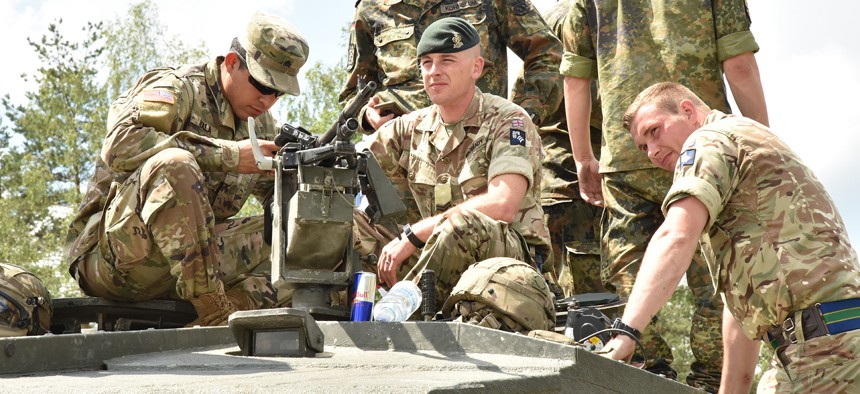
German, U.K., and U.S. tank platoons tour and inspect each other’s tanks before the opening ceremony of the Strong Europe Tank Challenge, held at 7th Army Training Command’s Grafenwoehr Training Area, June 3, 2018. U.S. Army / Lacey Justinger, 7th Army Training Command
What the UK Wants from the NATO Summit
Continue work on programs set in 2014 and 2016, and recognize the alliance’s immense value.
Every day, the North Atlantic Treaty Alliance, or NATO, helps protect ordinary citizens from the U.S., the UK and all its members from harm.
This week, leaders from all NATO countries will meet in Brussels to take stock, and ensure that the Alliance is fit, strong and agile enough to respond the many threats we face. The need to do this has been brought up numerous times by U.S. President Trump and by British Prime Minister May, and will be at the forefront of the Summit meeting.
When the North Atlantic Treaty was signed nearly 70 years ago, in the wake of a devastating world war, its founders might have recognized some of the challenges we have faced since then, including an aggressive and nuclear-armed Soviet Union – or today, Russia. But they might not have anticipated that the Alliance would also help us deal with things like state-sponsored cyber-attacks, instability in the Balkans or North Africa, or violent terrorist attacks like those we have fought collectively against in Afghanistan, Iraq, and Syria.
As one of NATO’s original architects and with the biggest defense budget in Europe, the UK wants this latest Summit to continue to deliver on the improvements set in train at the meeting we hosted in Wales in 2014 and continued at the meeting in Warsaw in 2016. That includes increasing defense spending: like the U.S., the UK is one of a handful of countries that have always exceeded NATO’s 2-percent spending target. We are pleased that other countries are also now stepping up: last year saw the biggest increases in defense spending across the Alliance in 25 years.
That’s not only good for strengthening our defense capabilities; it’s excellent news for the U.S. We’re focusing on American priorities, like counterterrorism, while bolstering the U.S. economy. This year, European allies are buying more than $35 billion of American products, such as F-35 Joint Strike Fighters, Poseidon P-8A Maritime Patrol Aircraft, Reaper drones, and billions of dollars in Patriot missile defense. UK’s defense spending alone is helping to employ more than 160,000 Americans. Over the next decade, the UK is investing more than $218 billion in modern and capable Armed Forces. That includes combat and surveillance aircraft; attack helicopters; attack and ballistic missile submarines; two aircraft carriers; and advanced armored vehicles.
We’re also enhancing our readiness and operational burden-sharing. From Iraq to Estonia, on land, sea and air, UK military personnel are contributing on NATO activity. And we are committing additional staff to NATO Command Structure, pushing our commitment past 1,000 UK personnel.
In recent months, NATO has provided crucial support in the wake of chemical weapons attacks in Syria, and the nerve agent attack in Salisbury. NATO is also bringing together an international team of scientists to design a system that will detect explosives on public transportation. It’s even helping Iraqi forces learn the skills to repair armored vehicles that are crucial in the fight against ISIL. This is in addition to many other things that the Alliance as a whole and individual Allies do, like training in Afghanistan and NATO’s four multilateral battlegroups that provide reassurance to Baltic states and Poland.
In an uncertain world, we cannot put a price tag on the value of an alliance that protects all of us. For nearly seven decades, NATO has stood as a bulwark against war, provided relief in natural disasters, increased the capacity of our partners to help themselves and been a protector of democratic values. As close allies in NATO, Permanent Members of the UN Security Council and leading nuclear powers, cooperation between the U.S. and UK is vital to international peace and security. Together, we will ensure that NATO remains as strong, stable and secure as the day it was first envisioned. And we must make sure that we are ready to protect and defend one another for generations to come.



